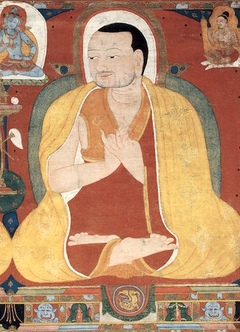Prayer to Pakmodrupa
Prayer Praising the Kāyas of Lord Pakmodrupa
by Yelpa Yeshe Tsek
Namo guru!
You realized the adamantine meaning of mind itself being unborn
And emerged victorious from battle with the afflictions and other foes.[1]
Working hard to help others, your enlightened mind filled with love—
Guru whose sublime name is so meaningful, to you, I bow.
Emerging from the sublime setting of dharmadhātu, beyond appearances,
In your compassion, benefitting beings in every way,
You appeared as the nirmāṇakāya whom I call my guru.[2]
With my body, speech, and mind filled with devotion, I bow my crown to your feet.
In the true meaning of equalness, there is no fluctuation between
Kaleidoscopic appearances and the mind’s ups and downs.
Guru, you who rests forever in equipoise—
Guru who is unchanging dharmakāya, to you, I bow.
Community of accomplished masters,
Maṇḍala of ḍākas and ḍākinīs, hosts of devas,
Assembly of destined bodhisattvas—
All like clouds continually massing over days and nights,
And you who revel in the ongoing state of unified emptiness and compassion—
Saṃbhogakāya guru, to you, I bow.
My own mind dawns as the guru of recognizing pristine awareness.
Kaleidoscopic appearances[3] dawn as the dharmakāya guru.
The six classes of being dawn as nirmāṇakāya gurus.
Illustrious triune guru,[4] to you, I bow.
You teach how devotion to the guru is the root of accomplishment,
How love and compassion are the root of the Great Vehicle,
And how unaltered cognition is the root of direct guidance.[5]
Illustrious one expert in these three instructions, to you, I bow.
Desire dawns as immaculate bliss.
Hostility dawns as immaculate love.
Benightedness dawns as immaculate luminosity.
Illustrious master of these three samādhis, to you, I bow.
The phenomenal world is attracted through the power of realization.
Blessings are attracted through the power of devotion.
The six classes of being are attracted through the power of compassion.
Illustrious master of the three attracting powers, to you, I bow.
Peerless, supreme protector of beings,
Who establishes destined ones on the path to liberation
Through the myriad interdependencies[6] of profound Secret Mantra—
Guru who has mastered magnificent skillful means, to you, I bow.
Guru, inspired and blessed by you,
I have tried to express some small part of the ocean of your enlightened qualities.
By this goodness, for all beings, may the sky of mind itself be perfectly purified;
May the unchanging view come about spontaneously;
May the flow of unwavering meditation never be broken;
May the ways of our body and speech be cured of desire and hostility;
And may the fruition of the three kāyas ripen within us.
In all my lives, may I never part from the authentic guru;
May I perfectly appreciate the Dharma’s splendor;
May I consummate the qualities of the levels and paths of the bodhisattvas;
And may I swiftly attain the state of Vajradhara!
This praise of Pakmodrupa’s kāyas was written by Yelpa Yeshe Tsek. Sarva maṅgalam.
| Translated by Joseph McClellan, 2024.
Bibliography
Source Text
'Gro mgon yel pa bkaʼ brgyud kyi gsung rab, vol. 1, pp. 187–189. BDRC MW1ER145.
Version: 1.0-20240904
-
The italicized words in these two lines are elements of Pakmodrupa’s name, Dorje (“adamantine”) and Gyal (“victorious”). ↩
-
A loose rendering of what would more literally be, “That nirmāṇakāya is my guru.” ↩
-
Literally, “white and red” (dkar dmar), an idiom for the diversity of things. ↩
-
“Triune guru” matches the uncommon Tibetan phrase bla ma sum ldan, lit., “guru with three [parts],” referring to the guru as equated with the three qualities above: as the experience of pristine awareness (rig pa’i ye shes), dharmakāya, and nirmāṇakāya. ↩
-
“Direct guidance” for gdams ngag (Sk. avavāda; upadeśa), often “oral instructions” or “essential advice” about meditation techniques. ↩
-
gsang ngag zab mo'i rten 'brel sna tshogs—referring primarily to the Vajrayāna’s rich ritual methods. ↩
